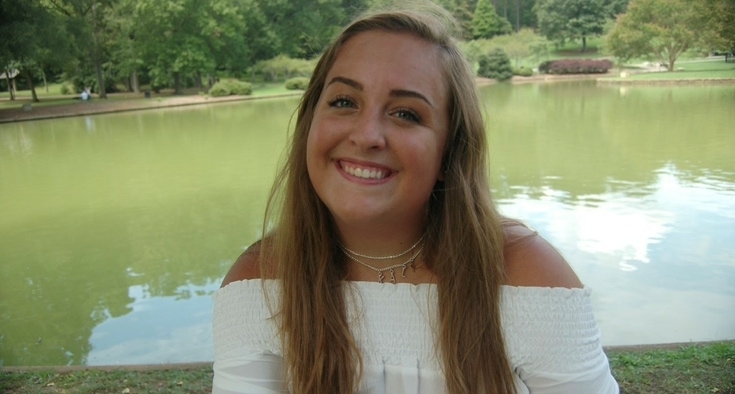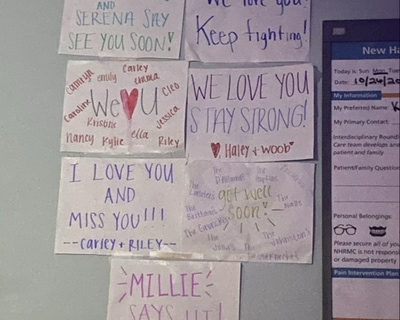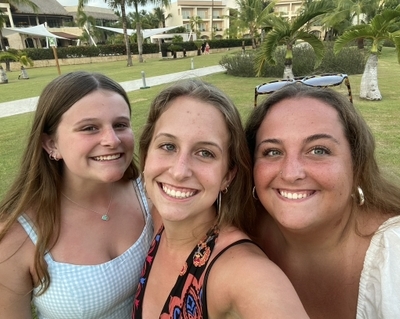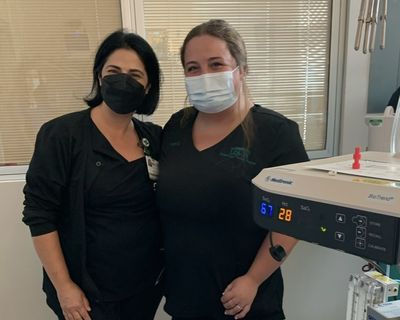New Hanover hospital team saved college student’s life. Now she wants to join them.

All walks of life fascinate Kalyn Groncki. So she felt right at home when she enrolled at University of North Carolina Wilmington in 2020 to study biology. But a couple of months into her freshman year, a near-fatal case of COVID-19 also gave her what she now calls a new sense of purpose.
While studying alone one October night, Groncki dismissed her throbbing head as a migraine, though she’d never had one. “I just knew something wasn’t right,” she remembered. After passing out in the shower more than once, Groncki pulled her hair back, crawled into bed and dialed 911. She could barely breathe.
Groncki was purple and in cardiac arrest when she arrived at Novant Health New Hanover Regional Medical Center. No one knew exactly what was wrong with her.
First to respond was Dr. Hector Sanchez, who specializes in critical care. He suspected a pulmonary embolism — a blood clot lodged in Groncki’s lungs — had choked off the oxygen to her blood. Her condition left only one option: life support.
Sanchez contacted Dr. Peter Kane, a cardiovascular and thoracic surgeon, one of two doctors at the hospital equipped to administer extracorporeal membrane oxygenation (ECMO). Kane hooked Groncki to the breathing tubes and used his last available tool to try to save her life. ECMO is a machine that can do the work of someone’s heart, lungs or both when they’re no longer able to get the job done.
“It’s the last-ditch effort,” said Paul Hubbard, manager of the cardiovascular ICU. “When we put somebody on ECMO, they’re dying.”
Her chances were 50/50. Groncki was numb to the machine inhaling and exhaling for her, and oblivious to the world. “I remember nothing,” she said, “until I woke up and saw my family in hazmat suits.”
She instantly recognized where she was. It felt like the ambulance had just brought her here. But Groncki had been comatose for eight days.
The COVID factor
In the fall of 2020, no vaccine was yet available, and most patients requiring ECMO treatment were COVID patients, said Cortney Fowler, who manages cardiovascular surgical services at New Hanover Regional Medical Center.
It turned out that Groncki had COVID, though she had tested negative for weeks. Earlier that fall, when she experienced chest pains, an urgent-care visit revealed a lung infection, not COVID. At the hospital, doctors believed Groncki’s body had responded in the form of blood clots. They determined a ventilator alone would not save her. But additional ECMO treatment would pull blood through an oxygenator, break down those clots and do Groncki’s breathing for her.

That early morning, six people made up Hubbard’s cardiovascular surgical team: an operating-room circulator, a first assistant, a nurse, the surgeon and two perfusionists who ran the life-support machine. Respiratory therapists Veronica Pittman and Cody Powell communicated with Groncki ’s parents throughout the treatment. Otherwise, Krista and Chad Groncki could only look through a glass door as they watched their oldest daughter fight for her life.
While Groncki slept, a GoFundMe campaign pleaded: “Continue to pray for a miracle.” After several days, it came. She was able to come off ECMO, go back on a ventilator and transfer to the COVID ICU. There, her younger sisters, Abygail and Haley, had decorated Groncki’s room with handwritten messages from home: “We love you! Keep fighting!”
She indeed had a fight ahead of her; she was still unconscious. And when she finally came to, Groncki could not talk, walk or eat without learning how to again. Speech and physical therapy followed, four times a week. Sitting down in a chair without help didn’t come easy at first. Rebuilding her strength, she realized, demanded baby steps.
It was unusual for an 18-year-old to require this level of treatment. It’s also a stark reminder that COVID hits everyone differently. But Groncki’s doctors say her age helped. Meanwhile, the ER was overrun with COVID patients, including many expectant mothers. Not everyone survived. “It was really a sad time,” Hubbard said. “But there were some great victories.”
Somewhere in that blur, Groncki remembers resting in front of a football game on TV when her mom and dad entered the room.
“I will never forget seeing them come through the double doors,” she recalled with a laugh. And though she could barely eke out any words, “it was a very special moment.”
Over nearly a month, Groncki’s parents and sisters had gotten to know Hubbard and his team. “They kind of became family,” he said. Given Groncki’s initial unresponsive condition, she didn’t get to properly meet Hubbard until after she left the hospital.
After 23 days, it was time to go home and prepare for spring semester.


“She is a huge reason why I chose the profession.”
Discovery through recovery
A month later, Groncki’s mom showed Groncki an issue of UNCW Magazine that would change everything — again.
An ad inside promoted the university’s new respiratory therapy program at the School of Health and Applied Human Sciences. Groncki immediately ripped out the page and taped it to the wall. “This is my goal,” she told herself. “This is what I want to do.”
As COVID continued to ravage the U.S. and kill more than 1 million people, the public would come to learn that respiratory therapists were frontline heroes in the fight to save lives.
Groncki says her own experience has inspired her to help save patients. During her first semester in respiratory therapy, Groncki took her classmates on an impromptu field trip to the intensive care unit, where she introduced them to Hubbard and the team.
“They deserve so much recognition,” Groncki said. “They picked up their whole lives to support me.”
Groncki, who turns 21 in April, said she expects other students would run from respiratory therapy had they experienced what she had. But she’s never felt more blessed, and, after graduation, she hopes to work at the Wilmington hospital with the doctors who kept her alive.
“I have fallen in love with this program. I just keep healing,” Groncki said. “I would have never chosen respiratory therapy if it wasn’t for this. And I thank God every day that I did.”